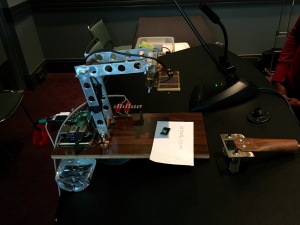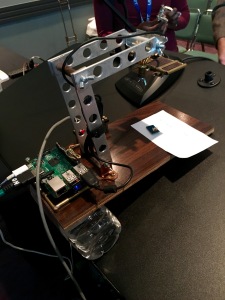These are my notes from the Leland Melvin keynote at the 2016 FETC conference.
Presenter
They are playing David Bowie before the keynote starts!
STEM Excellence Awards
Before the speaker begins, they are giving away the FETC STEM awards. Several nominees are from Washington! More information in both 1805 in the Expo Hall.
Introduction
- Played for the Lions and the Cowboys.
- BS in chemistry and MS in material design.
- Flew on Space Shuttle Atlantis.
- 24 years with NASA.
Keynote Adress

- The right stuff is the never give up stuff.
- Everyone literally had a hand in my development, makes smacking gesture with hand:)
- Parents were both middle school teachers.
- Was 4 for moon landing in 1969.
- Talking about actress Grace Nichols who played Uhura on Star Trek, and influence on race and gender in 1960’s. She met MLK and he told her not to quit the show. NASA later hired her to recruit women and minorities.
- Made his own skateboard, example of childhood engineering.
- Tells a story of the Merita Bread truck his dad bought to use as an RV. They re-engineered it over the summer. “Anything we do can be a teaching moment”. “That is when I became an engineer”.
- Got a chemistry set was age inappropriate. “I blew things up in the living room”, “that is when I became a scientist”.
- Played high school football. He dropped the ball during the homecoming game. Coach told him to try again, ran the same play and he caught the ball to make a touchdown. This led to him receiving scholarship for University of Richmond.
- Played for the Lions and then the Cowboys, then went back to college after an injury prevented him from playing.
- Worked on a design for a replacement to the Space Shuttle, eventually applied for astronaut program.
- Shows picture in which he was the only black astronaut in his class.
- Lost hearing during EVA suit training in a pool. It s lowly came back, but was medically disqualified from flying space.
- Became a recruiter to get kids interested in space.
- After the Columbia disaster, was sent to talk to David Brown’s parents. They tell him “we must keep flying”.
- Gets a medical waiver to be allowed to fly.
- Path from blue flight suit to orange pumpkin suit was full of mistakes.
- 2008 and 2009 went to ISS. Job was to work on the robotics. He had to use the big robot arm first flight. Added a module for the German program.
- The orbital perspective, or orbital shift: seeing a sunrise or sunset every 45 minutes, seeing all of humanity below, and working with an international family.
- Shows video of Space Shuttle launch.
- “Only possible because I had a team that believed in me.”
- Stupid astronaut tricks get kids stoked to be astronauts.
- Shows picture of sketch notes with 3 questions:
- How to prepare students for jobs we can’t image?
- How to ensure all students can meet level of rigor?
- How to build learning experiences that spark passion?
- Parents taught him empathy, to care about others.















You must be logged in to post a comment.